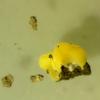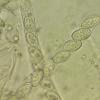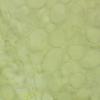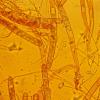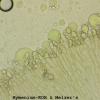
16-11-2025 21:09
 Robin Isaksson
Robin Isaksson
Anyone recognize this acc. to pictures.? Found on

18-11-2025 13:59
Nogueira HéctorNovember 14, 2025 Brazuelo (León) SPAIN Hymenosc

17-11-2025 19:14
herman lambertApothécie discoïde 0.6 cm diam., orangeFace hym�

17-11-2025 21:57
Philippe PELLICIERBonjour,Récolté sur bois de feuillu mort dur, no

17-11-2025 21:46
Philippe PELLICIERBonjour,Récolté sur bois pourrissant de feuillu

14-11-2025 16:26
 Marian Jagers
Marian Jagers
Hello everyone, On dead wood of Cytisus scoparius

15-11-2025 23:22
Mario FilippaHello,this is what I think to be Hymenoscyphus mac

15-11-2025 20:25
 Riet van Oosten
Riet van Oosten
Hello, Found by Laurens van der Linde, Nov. 2025

Hi All,
For a couple of months I have been finding yellow apothecia on bare damp soil in shrub borders of my garden. They are 1-3mm and bowl to disc shaped. The spores are usually multiguttulate and measure 15-21x9-10 and the cylindric asci are 200-280x10-13. No blueing in iodine was observed. Did not find croziers. The paraphyses are curved, septate and slightly swollen to 3 at the apex. A distinctive feature is that the paraphyses and ascus tips are glued together with yellowish amorphous matter. In Melzer's this disperses into yellow drops. Excipulum is a Textura Globosa. I think we are looking at an operculate disco but am struggling even to get to genus.
Thanks in advance,
Charles.


Cheilymenia I know without conspicuous contents of the spores (?).
Best regards, Lothar

Hi Chris,
Not aware any hairs. Also a bit small for C. vitellina
Cheers,
Charles.

Here is a slightly better photo of the apothecia, this time with sparse mosses, but in other spots there was no moss at all.
Charles.
I have received the suggestion of Boubovia/Pseudoboubovia from Marcel Vegas. I think I had ruled out Boubovia but I was unaware of Pseudoboubovia. It turns out that Pseudoboubovia benkertii, with its multiguttulate ascospores, is an excellent fit!


Hi Chris,
Wel, I always scan the soil surface when I'm gardening. Just in case! It turns out that this fungus is associated with my Cupressus hedge!
Yes, I think the genus might be new to Britain and I'll let Paul Cannon know.
Best wishes,
Charles.

